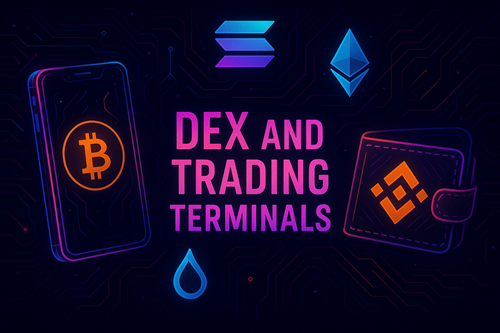Your Keys Your Crypto: A Guide to Self Custody
- Shy Girl
- Jul 28
- 4 min read
Updated: Sep 6
The phrase “Not your keys, not your crypto” has echoed through the crypto community for years—and for good reason. It’s a reminder that ownership in the world of digital assets is determined by control over your private keys. If someone else holds them, they control your assets—not you. That’s why self-custody is the cornerstone of true financial sovereignty in crypto.

In this guide, we’ll break down what self-custody means, the tools you'll need, and how to navigate key parts of the crypto ecosystem—on-ramping, trading, and offboarding—without giving up control.
What is Self-Custody?
Self-custody means taking full responsibility for storing, securing, and managing your own cryptocurrencies. Unlike centralized exchanges where your funds are held in custodial wallets (controlled by the platform), self-custody puts you in control.
This means:
You own your private keys
You are solely responsible for backup and recovery
You don’t rely on third parties to access or move your funds
While self-custody offers unmatched control and privacy, it also demands diligence in security practices. Losing your private key or seed phrase can mean permanent loss of access to your funds.

Digital Wallets: Your Self-Custody Vault
To self-custody your crypto, you need a digital wallet. These come in several forms, but all serve the same purpose: they store your private keys securely and allow you to interact with blockchains.
Types of Wallets:
Hot Wallets (Software Wallets):
Connected to the internet
Convenient for frequent use
Examples
Phantom Wallet — SOLANA, ETHEREUM, POLYGON, BITCOIN
SOLFLARE — Solana Dedicated Wallet
MetaMask Ethereum and EVM-compatible blockchains
For XRP enthusiasts, Xumm
WalletEthos Wallet is purpose-built for the Sui blockchain
fWallet is Fantom‘s native wallet
Core Wallet, developed by Ava Labs, is the ultimate choice for Avalanche users.
TronLink Wallet is the go-to software wallet for the Tron ecosystem
TonKeeper — Built for TONCOIN Transactions and DeFi
Mobile Wallets:
App-based wallets for phones
Useful for on-the-go transactions
Examples:
Tip: Always back up your wallet’s seed phrase and store it offline in a secure location.

On-Ramping: How to Buy Crypto Into Your Wallet
On-ramping is the process of converting fiat currency (like USD, EUR, or GBP) into cryptocurrency. While most centralized exchanges offer on-ramps, many self-custody options now support non-custodial on-ramps.
Ways to On-Ramp to Self-Custody:
Integrated Fiat On-Ramp Services: Many wallets now include services like MOONSHOT or Phantom Wallet allowing you to buy crypto directly into your self-custodied wallet using a credit card, bank transfer, or Apple Pay.
Use of ATMs or Local Crypto Services: Some crypto ATMs and services allow direct deposit into personal wallets.
Buy off Centralized Exchanges (CEX)
BITMART: Spot/Perps
LBANK: Spot/Perps Perps
BITRUE: Spot/Perps
HTX GLOBAL: Spot/Perps
NEWTON: Onboard/Offboard Crypto
Ensure you verify the wallet address before purchasing and confirm it supports the asset you're buying.

DEX: Trading Without Intermediaries
A Decentralized Exchange (DEX) allows you to trade crypto assets directly from your wallet, without transferring them to a centralized platform. This is critical for maintaining full control during trades.
Benefits of DEXs:
No account registration
No custodial risk
Full transparency of funds and trades
Popular DEX Examples:
PADRE: SOL/ETH/BASE/BSC/TRON/AVAX
BONK TELEMETRY: SOLANA Trading Bot/WebApp Hybrid
DBOTDEX: SOL/ETH/BASE/BSC/TRON Trading Bot/WebApp Hybrid
ASTERDEX: Decentralized Perpetuals SOL ETH BASE BSC
SPHYNX LABS: MultiChain DEX 17 Chains
APEX: MultiChain Perps
RAYDIUM: Solana DEX
AXIOM: Solana . Trade, Perps, Yield
QUANTO TRADE : Spot/Defi Pepetual Trading.
Always confirm you're using the official site or smart contract, as DEX interfaces can be imitated by phishing sites.

Telegram Trading Bots: Speed Meets Convenience
In recent years, Telegram trading bots have surged in popularity. These bots allow users to connect wallets and execute trades via Telegram’s chat interface, often with lightning speed and automation features.
Why Use Telegram Bots?
Quick execution of token snipes
Easy UI for rapid trades
Integration with wallet management tools
Alerts and portfolio tracking
Examples of Telegram Bots:
TROJAN: Solana
BASED BOT: SOL/ETH/BASE/BNB/AVAX/ABSTRACT/ARB/HYPER
MAESTRO: SOL/ETH/BASE/BSC/TRON/AVAX/HYPE/TON
SIGMA: ETH/AVAX/BASE/UNICHAIN/BERACHAIN
BONKBOT (TELEMERY): Solana
DBOT: SOL/ETH/BASE/BNB/AVAX/SUI/TRX
REKT BOT: Solana
SHURIKEN: SOL/ETH/BASE/BSC/HYPE/AVAX/TRX/SUI
MAGNUM: SOL/ETH/BASE/BNB/AVAX
VORTEX: PumpFun Deployer Bot/MultiWallet Batching/Volume Booster
Caution: Only use bots that allow non-custodial interaction and avoid granting full access to your private keys.
Solana Token Discovery
WOM.FUN: Professional sentiment tracking
BUBBLEMAPS: On Chain Visual Analysis
0xBOT Ai Agent: Telegram Bot with Degen Calls on New Pairs
AXIOM: Solana . Trade, Perps, Yield
PADRE: SOL/ETH/BASE/BSC/TRON

Offboarding: Converting Crypto Back to Fiat
Eventually, you may want to offboard—that is, convert your crypto holdings back into fiat currency. This can be done while maintaining self-custody until the last step.
Offboarding Options:
Non-Custodial Off-Ramp Services: Some services allow you to sell crypto from your wallet and receive fiat in your bank account. Examples: NEWTON:
P2P Selling: Sell directly to another person and receive fiat via cash, PayPal, or bank transfer
Gift Cards or Prepaid Cards: Services that let you convert crypto into gift cards or load onto prepaid debit cards
PINTOPAY: NON KYC Credit Card — Telegram Interface — ApplePay, GooglePay Compatible
BONKPAY: No Kyc Crypto Visa Card, ApplePay and GooglePay
xKARD: Non KYC Visa Cards, ApplePay and GooglePay, Use Worldwide, Load with USDT
SOLCARD: Solana DeFi OffBoarding. Apple Pay Compatible Digital Visa
KAST: Mobile App Offering A Crypto Top Up Visa
Offboarding requires caution around regulatory compliance, KYC requirements, and scam risks.
Conclusion: Take Control of Your Crypto Journey
Self-custody is about more than just avoiding centralized failures—it’s about freedom, privacy, and true ownership. But with great power comes great responsibility. By educating yourself on wallets, secure practices, and decentralized tools, you become your own bank.
So the next time someone asks why you self-custody your crypto, remind them:“Because my keys mean my freedom.”
Need help setting up your wallet or navigating your first DEX trade? Reach out or leave a comment below!



Comments